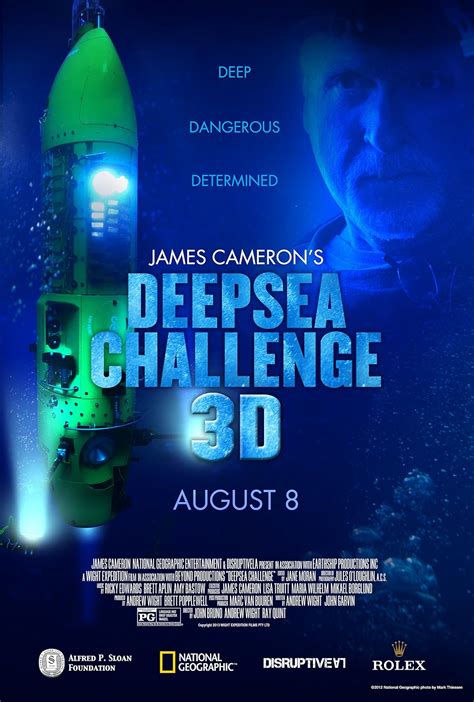What is National Geographic Entertainment Deepsea Challenge?
National Geographic Entertainment's Deepsea Challenge is a captivating exploration of the deepest, darkest parts of the ocean. This project was spearheaded by James Cameron, the renowned director behind acclaimed films such as Titanic and Avatar. As a passionate explorer and filmmaker, Cameron's goal was to shed light on the mysteries of the ocean and the incredible species that call it home.
The Deepsea Challenge expedition was a remarkable feat of engineering, consisting of a submersible that could descend to the deepest parts of the Mariana Trench. This submersible, known as the Deepsea Challenger, was equipped with state-of-the-art technology, including high-definition cameras and powerful lights, to capture footage of the ocean floor like never before.
The expedition was no small task, and Cameron faced many challenges along the way. He had to navigate treacherous underwater terrain, avoid the dangers of diving too deep, and deal with technical difficulties during the dive itself. However, his perseverance paid off, and the Deepsea Challenge team was able to collect valuable data and footage that would help researchers better understand the ocean's ecosystem.
The journey was documented by National Geographic Entertainment and has since been released as a documentary film. This film offers a window into the fascinating world that exists beneath the waves, showcasing the beauty and wonder of the ocean's depths. It also highlights the importance of conservation and the need to protect our oceans from human impact.
Overall, National Geographic Entertainment's Deepsea Challenge is a groundbreaking exploration of the ocean's depths, offering a glimpse into a world few have seen before. It's a testament to human ingenuity and our quest to unravel the mysteries of the natural world.
Frequently Asked Questions about national geographic entertainment deepsea challenge
Unlike the Trieste, which spent only 20 minutes on the ocean floor and had no research or camera equipment, the DEEPSEA CHALLENGER was designed as a science platform and was able to remain at the bottom of the Mariana Trench for three hours to explore, take samples and capture the first-ever high-resolution images of ...
Cameron's dive in his specially designed submersible marks the launch of Deepsea Challenge, a joint scientific project by Cameron, the National Geographic Society and Rolex to conduct deep-ocean research and exploration to expand our knowledge and understanding of these largely unknown parts of the planet.
The biggest section, the "beam," is made of a new kind of syntactic foam, the only flotation material capable of withstanding the crushing pressures of the deep ocean.
Specifications. The submersible features a pilot sphere, large enough for only one occupant. The sphere, with steel walls 64 mm (2.5 in) thick, was tested for its ability to withstand the required 114 megapascals (16,500 pounds per square inch) of pressure in a pressure chamber at Pennsylvania State University.
The Challenger Deep is the deepest place in the world's oceans. It is a slot at the southern end of the Marianas Trench. The ocean floor is about seven miles beneath the surface of the Pacific Ocean in the slot. Geologists list the official depth at this time as 39,994 feet.
The first recordings of the depth of the trench were made by the British Royal Navy Challenger expedition in 1875, using a weighted rope, which recorded a depth of 4,475 fathoms (8,184 meters; 26,850 feet).
These depths are also subject to extreme pressure, from about 40 to over 110 times the pressure of Earth's atmosphere. This means the “deep” is the part of our ocean that is dark, cold, food-poor, subject to intense pressure, and typically deeper than 200 meters.
About three-fourths of the area covered by ocean is deep, permanently dark, and cold. This is the deep sea. Most are familiar with the surface layer, which extends down 650 feet (200 m) and receives the most sunlight, allowing photosynthetic organisms like phytoplankton to convert sunlight to energy.
Challenger Deep is approximately 10,935 meters (35,876 feet) deep. It is named after the HMS Challenger, whose crew first sounded the depths of the trench in 1875.
D+I were selected by James Cameron and Ron Allum of the Acheron Project as the preferred Australian industrial design team to develop the cockpit layout for the Deepsea Challenger's record dive to the bottom of the Mariana Trench.
Challenger Deep is approximately 10,935 meters (35,876 feet) deep. It is named after the HMS Challenger, whose crew first sounded the depths of the trench in 1875.
The Challenger didn't actually explode.
A cloud of fire engulfed the space shuttle just 73 seconds after liftoff, at an altitude of some 46,000 feet (14,000 meters). It looked like an explosion, the media called it an explosion and even NASA officials mistakenly described it that way initially.
Ten Things to Know About the Mariana Trench – the Deepest Part of the Ocean
- It's deeper than the highest mountain is tall.
- There are a Lot of Birthday Candles to Blow Out.
- Things Do Live There.
- When Was It Discovered?
- The Challenger Deep is Deepest.
- Someone has Traveled to the Bottom.
- It's Hot and It's Cold.
“The intense pressures in the deep ocean make it an extremely difficult environment to explore.” Although you don't notice it, the pressure of the air pushing down on your body at sea level is about 15 pounds per square inch. If you went up into space, above the Earth's atmosphere, the pressure would decrease to zero.












